文章目录
12.9 map/multimap容器
12.9.1 map基本概念
简介:
- map中所有元素都是pair
- pair中第一个元素为key(键值),起到索引作用,第二个元素为value(实值)
- 所有元素都会根据元素的键值自动排序
本质:
- map/multimap属于关联式容器,底层结构是用二叉树实现。
优点:
- 可以根据key值快速找到value值
map和multimap的区别:
- map不允许容器中有重复key值元素
- multimap允许容器中有重复key值元素
12.9.2 map构造和赋值
功能描述:
- 对map容器进行构造和赋值操作
函数原型:
构造:
- map<T1, T2>mp; //map默认构造函数
- map(const map &mp);//拷贝构造函数
赋值:
- map& operator=(const map &mp); //重载等号操作符
示例代码:
#include<iostream>
#include<string>
using namespace std;
#include<map>
//map容器 构造和赋值
void printMap(map<int, int>& m)
{
for (map<int, int>::iterator it = m.begin(); it != m.end(); it++)
{
cout << " key = " << (*it).first << " value = " << it->second << endl;
}
cout << endl;
}
void test11()
{
//创建map容器
map<int, int>m;
m.insert(pair<int, int>(3, 30));
m.insert(pair<int, int>(2, 20));
m.insert(pair<int, int>(4, 40));
m.insert(pair<int, int>(1, 10));
cout << " -----------------m-----------------" << endl;
printMap(m);
//拷贝构造
map<int, int>m2(m);
cout << " -----------------m2-----------------" << endl;
printMap(m2);
//赋值操作
map<int, int> m3;
m3 = m2;
cout << " ------------------m3-----------------" << endl;
printMap(m3);
}
int main()
{
test11();
system("pause");
return 0;
}
运行结果:
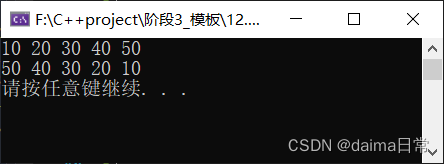
总结: map中所有元素都是成对出现,插入数据时要使用对组。
12.9.3 map大小和交换
功能描述:
- 统计map容器大小以及交换map容器
函数原型:
- size(); //返回容器中元素的数目
- empty(); //判断容器是否为空
- swap(st); //交换两个集合容器
示例代码:
#include<iostream>
#include<string>
using namespace std;
#include<map>
//map容器 大小和交换
void printMap2(map<int, int>& m)
{
for (map<int, int>::iterator it = m.begin(); it != m.end(); it++)
{
cout << " key = " << it->first << " value = " << it->second << endl;
}
cout << endl;
}
//大小
void test21()
{
map<int, int>m;
m.insert(pair<int, int>(4, 40));
m.insert(pair<int, int>(3, 30));
m.insert(pair<int, int>(5, 50));
m.insert(pair<int, int>(1, 10));
m.insert(pair<int, int>(2, 20));
printMap2(m);
if (m.empty())
{
cout << "m为空" << endl;
}
else
{
cout << "m不为空" << endl;
cout << "m的大小为:" << m.size() << endl;
}
}
//交换
void test22()
{
map<int, int>m;
m.insert(pair<int, int>(4, 40));
m.insert(pair<int, int>(3, 30));
m.insert(pair<int, int>(5, 50));
map<int, int>m2;
m2.insert(pair<int, int>(8, 40));
m2.insert(pair<int, int>(9, 70));
m2.insert(pair<int, int>(7, 50));
cout << "交换前:" << endl;
printMap2(m);
printMap2(m2);
m.swap(m2);
cout << "交换后:" << endl;
printMap2(m);
printMap2(m2);
}
int main()
{
//test21();
test22();
system("pause");
return 0;
}
运行结果:
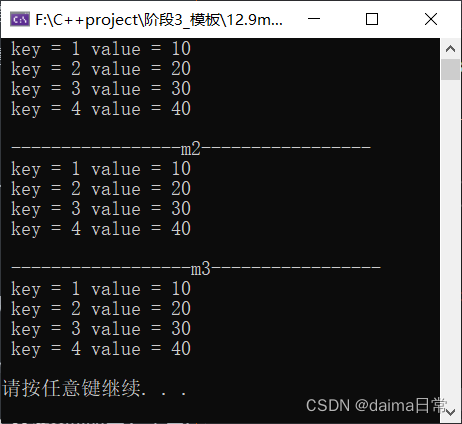
总结:
- 统计大小 — size
- 判断是否为空 — empty
- 交换容器 ---- swap
12.9.4 map插入和删除
功能描述:
- map容器进行插入数据和删除数据
函数原型:
- insert(elem); //在容器中插入元素
- clear(); //清除所有元素
- erase(pos); //删除pos迭代器所指向的元素,返回下一个元素的迭代器
- erase(beg,end); //删除区间[beg,end]的所有元素,返回下一个元素的迭代器
- erase(key); //删除容器中值为key的元素
示例代码:
#include<iostream>
#include<string>
using namespace std;
#include<map>
//map容器 插入和删除
void printMap3(map<int, int>& m)
{
for (map<int, int>::iterator it = m.begin(); it != m.end(); it++)
{
cout << " key = " << it->first << " value = " << it->second << endl;
}
cout << endl;
}
void test31()
{
map<int, int>m;
//插入
//第一种
m.insert(pair<int,int>(1,10));
//第二种
m.insert(make_pair(2, 20));
//第三种
m.insert(map<int, int>::value_type(3, 30));
//第四重
m[4] = 40;
//不建议使用[]插入,可以使用key访问到value
//cout << m[5] << endl;
cout << m[4] << endl;
printMap3(m);
//删除
m.erase(m.begin());
printMap3(m);
//按照key删除
m.erase(3);
printMap3(m);
//清空操作
//m.erase(m.begin(),m.end());
m.clear();
printMap3(m);
}
int main()
{
test31();
system("pause");
return 0;
}
运行结果:
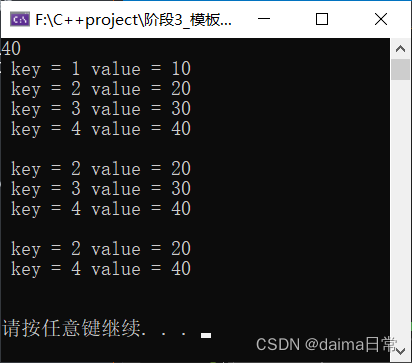
总结:
- map 插入方式很多,记住其一即可
- 插入 — insert
- 删除 — erase
- 清空 — clear
12.9.5 map查找和统计
功能描述:
- 对map容器进行查找时间以及统计数据
函数原型:
- find(key); //查找key是否存在,若存在,返回该键的元素的迭代器;若不存在,返回set.end();
- cout(key); //统计key的元素个数
示例代码:
#include<iostream>
#include<string>
using namespace std;
#include<map>
//map容器 查找和统计
void test41()
{
//查找
map<int,int>m;
m.insert(make_pair(1, 10));
m.insert(make_pair(4, 40));
m.insert(make_pair(2, 20));
m.insert(make_pair(3, 30));
m.insert(make_pair(3, 30));
map<int, int>::iterator pos = m.find(6);
if (pos != m.end())
{
cout << " 查找到元素的 key = " << pos->first << " value = " << pos->second << endl;
}
else
{
cout << "没有找到该元素" << endl;
}
//统计
//map不允许插入重复key元素,cout统计而言,结果要么是0要么是1
//multimap的count统计可以大于1
int num = m.count(3);
cout << " num = " <<num<< endl;
}
int main()
{
test41();
system("pause");
return 0;
}
运行结果:
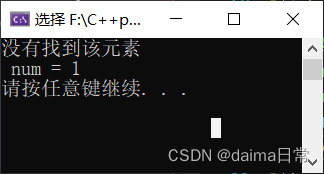
总结:
- 查找 ---- find (返回的是迭代器)
- 统计 ---- count(对于map而言结果为0或1)
12.9.6 map容器排序
学习目标:map容器默认排序规则为按照key值进行从小到大排序,掌握如何修改排序规则
主要技术点:
- 利用仿函数,可以改变排序规则
示例代码:
#include<iostream>
#include<string>
using namespace std;
#include<map>
//map容器 排序
class MyCompare
{
public:
bool operator()(int v1, int v2) const
{
return v1 > v2;
}
};
void test51()
{
map<int, int,MyCompare>m;
m.insert(make_pair(1, 10));
m.insert(make_pair(3, 30));
m.insert(make_pair(2, 20));
m.insert(make_pair(4,40));
for (map<int, int, MyCompare>::iterator it = m.begin(); it != m.end(); it++)
{
cout << " key = " << it->first << " value = " << it->second << endl;
}
}
int main()
{
test51();
system("pause");
return 0;
}
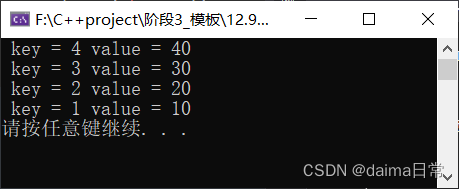
总结:
- 利用仿函数可以指定map容器的排序规则
- 对于自定义数据类型,map必须要指定排序规则,像set容器一样
如果对你有帮助的话,请不要忘了给我一点点点…支持 ( ^ o ^)/~






















 725
725











 被折叠的 条评论
为什么被折叠?
被折叠的 条评论
为什么被折叠?








